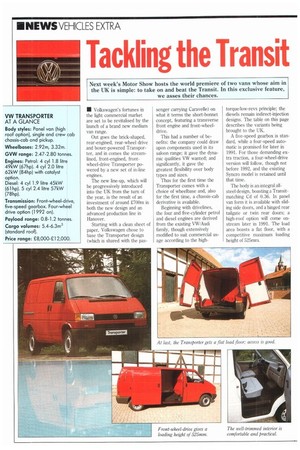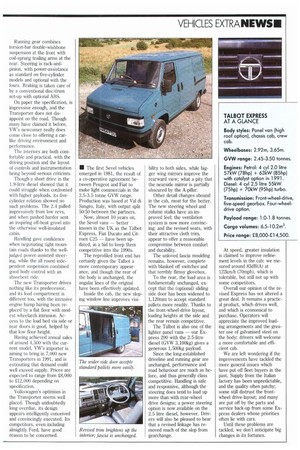Tackling the Transit
Page 26

Page 27

If you've noticed an error in this article please click here to report it so we can fix it.
Next week's Motor Show hosts the world premiere of two vans whose aim in the UK is simple: to take on and beat the Transit. In this exclusive feature, we asses their chances.
• Volkswagen's fortunes in the light commercial market are set to be revitalised by the launch of a brand new medium van range.
Out goes the brick-shaped, rear-engined, rear-wheel drive and boxer-powered Transporter, and in comes the streamlined, front-engined, frontwheel-drive Transporter powered by a new set of in-line engines.
The new line-up, which will be progressively introduced into the UK from the turn of the year, is the result of an investment of around 2700m in both the new design and an advanced production line in Hanover.
Starting with a clean sheet of paper, Volkswagen chose to base the Transporter design (which is shared with the pas
senger carrying Caravelle) on what it terms the short-bonnet concept, featuring a transverse front engine and front-wheeldrive.
This had a number of benefits: the company could draw upon components used in its saloon range; it gave the dynamic qualities VW wanted; and significantly, it gave the greatest flexibility over body types and sizes.
Thus for the first time the Transporter comes with a choice of wheelbase and, also for the first time, a chassis-cab derivative is available.
Beginning with drivelines, the four and five-cylinder petrol and diesel engines are derived from the existing VW/Audi family, though extensively modified to suit commercial usage according to the high
torque/low-revs principle; the diesels remain indirect-injection designs. The table on this page describes the variants being brought to the UK.
A five-speed gearbox is standard, while a four-speed automatic is promised for later in 1991. For those demanding extra traction, a four-wheel-drive version will follow, though not before 1992, and the existing Syncro model is retained until that time.
The body is an integral allsteel design, boasting a Transitmatching Cd of 0.36. In panel van form it is available with sliding side doors, and a hinged rear tailgate or twin rear doors; a high-roof option will come onstream later in 1991. The load area boasts a flat floor, with a competitive maximum loading height of 525mm. Running gear combines torsion-bar double-wishbone suspension at the front with coil-sprung trailing arms at the rear. Steering is rack-andpinion, with power-assistance as standard on five-cylinder models and optional with the fours. Braking is taken care of by a conventional disc/drum set-up with optional ABS.
On paper the specification, is impressive enough, and the Transporter does not disappoint on the road. Though many have claimed it before, VW's newcomer really does come close to offering a carlike driving environment and performance.
The interiors are both comfortable and practical, with the driving position and the layout of controls and instrumentation being beyond serious criticism.
Though a short drive in the 1.9-litre diesel showed that it could struggle when confronted with higher payloads, its fivecylinder relation showed no such problems. The 2.4 pulled impressively from low revs, and when pushed harder sent an inspiring off-beat growl into the otherwise well-insulated cabin.
Handling gave confidence when negotiating tight mountain roads thanks to the welljudged power-assisted steering, while the all round independent suspension combined good body control with an absorbent ride.
The new Transporter drives nothing like its predecessor, and its load compartment is different too, with the intrusive engine hump having been replaced by a flat floor with modest wheelarch intrusion. Access to the load bed via side or rear doors is good, helped by that low floor height.
Having achieved annual sales of around 4,500 with the current model, VW's importer is aiming to bring in 7,000 new Transporters in 1991, and is estimating that demand could well exceed supply. Prices are expected to range from £8,000 to £12,000 depending on specification.
Volkswagen's optimism in the 'Transporter seems well placed. Though undoubtedly long overdue, its design appears intelligently conceived and convincingly executed. Its competitors, even including almightly Ford, have good reason to be concerned. • The first Sevel vehicles emerged in 1981, the result of a co-operative agreement between Peugeot and Fiat to make light commercials in the 2.5-3.5 tonne GVW range. Production was based at Val di Sangro, Italy, with output split 50/50 between the partners.
Now, almost 10 years on,
the Sevel vans better known in the UK as the Talbot Express, Fiat Ducat° and Cit roen C25 have been updated, in a bid to keep them competitive into the 1990s.
The reprofiled front end has certainly given the Talbot a more contemporary appearance, and though the rear of the body is unchanged, the angular lines of the original have been effectively updated.
Inside the cab, the new sloping window line improves visi bility to both sides, while bigger wing mirrors improve the rearward view; what a pity that the nearside mirror is partially obscured by the A-pillar.
• Other detail changes abound in the cab, most for the better. The new steering wheel and column stalks have an improved feel; the ventilation system is now more convincing; and the revised seats, with their attractive cloth trim, appear to offer a reasonable compromise between comfort and durability.
The unloved fascia moulding remains, however, complete with blanked off switches and that terribly flimsy glovebox.
To the rear, the load area is fundamentally unchanged, except that the (optional) sliding side door has been widened to 1,120mm to accept standard pallets more readily. Thanks to the front-wheel-drive layout, loading heights at the side and the rear remain competitive.
The Talbot is also one of the lighter panel vans — our Express 290 with the 2.5-litre diesel (GVW 3,100kg) gives a generous 1,500kg payload.
Since the long-established driveline and running gear are unchanged, performance and road behaviour are much as before, and thus generally class competitive. Handling is safe and responsive, although the steering does tend to load up more than with rear-wheel drive designs; a power steering option is now available on the 2.5 litre diesel, however. Drivers will also be pleased to hear that a revised linkage has removed much of the slop from gearchange.
At speed, greater insulation is claimed to improve refinement levels in the cab: we mesured around 83dB(A) at 122kmih (70mph), which is tolerable, but still not up with some competitors.
Overall our opinion of the revised Express has not altered a great deal. It remains a practical product, which drives well, and which is economical to purchase. Operators will appreciate the improved loading arrangements and the greater use of galvanised steel on the body; drivers will welcome a more comfortable and efficient cab.
We are left wondering if the improvements have tackled the more general issues which have put off fleet buyers in the past. Supply from the Italian factory has been unpredictable, and the quality often patchy; some still distrust the frontwheel drive-layout; and many are put off by the parts and service back-up from some Express dealers whose priorities often lie with cars.
Until these problems are tackled, we don't anticipate big changes in its fortunes.




































































































